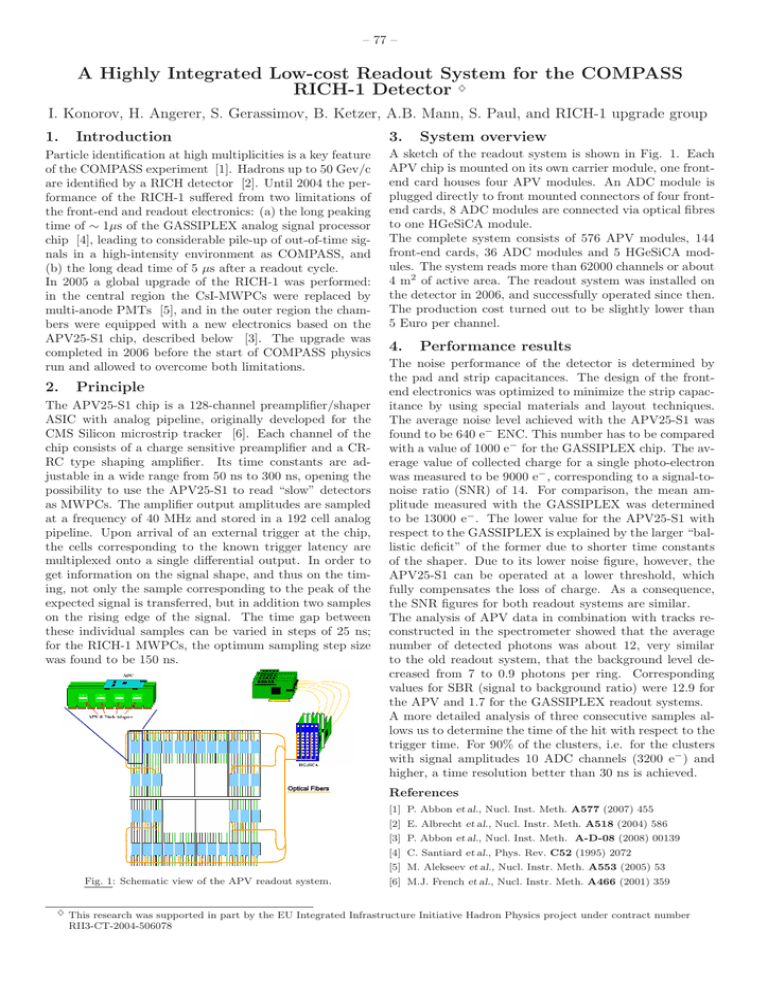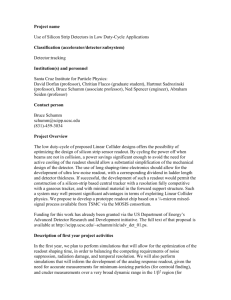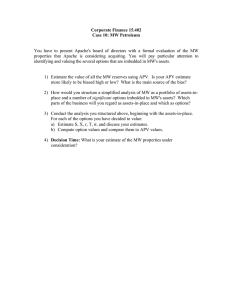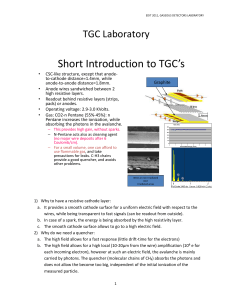A Highly Integrated Low-cost Readout System for the COMPASS
advertisement

– 77 – A Highly Integrated Low-cost Readout System for the COMPASS RICH-1 Detector ♦ I. Konorov, H. Angerer, S. Gerassimov, B. Ketzer, A.B. Mann, S. Paul, and RICH-1 upgrade group 1. Introduction Particle identification at high multiplicities is a key feature of the COMPASS experiment [1]. Hadrons up to 50 Gev/c are identified by a RICH detector [2]. Until 2004 the performance of the RICH-1 suffered from two limitations of the front-end and readout electronics: (a) the long peaking time of ∼ 1µs of the GASSIPLEX analog signal processor chip [4], leading to considerable pile-up of out-of-time signals in a high-intensity environment as COMPASS, and (b) the long dead time of 5 µs after a readout cycle. In 2005 a global upgrade of the RICH-1 was performed: in the central region the CsI-MWPCs were replaced by multi-anode PMTs [5], and in the outer region the chambers were equipped with a new electronics based on the APV25-S1 chip, described below [3]. The upgrade was completed in 2006 before the start of COMPASS physics run and allowed to overcome both limitations. 2. Principle The APV25-S1 chip is a 128-channel preamplifier/shaper ASIC with analog pipeline, originally developed for the CMS Silicon microstrip tracker [6]. Each channel of the chip consists of a charge sensitive preamplifier and a CRRC type shaping amplifier. Its time constants are adjustable in a wide range from 50 ns to 300 ns, opening the possibility to use the APV25-S1 to read “slow” detectors as MWPCs. The amplifier output amplitudes are sampled at a frequency of 40 MHz and stored in a 192 cell analog pipeline. Upon arrival of an external trigger at the chip, the cells corresponding to the known trigger latency are multiplexed onto a single differential output. In order to get information on the signal shape, and thus on the timing, not only the sample corresponding to the peak of the expected signal is transferred, but in addition two samples on the rising edge of the signal. The time gap between these individual samples can be varied in steps of 25 ns; for the RICH-1 MWPCs, the optimum sampling step size was found to be 150 ns. 3. System overview A sketch of the readout system is shown in Fig. 1. Each APV chip is mounted on its own carrier module, one frontend card houses four APV modules. An ADC module is plugged directly to front mounted connectors of four frontend cards, 8 ADC modules are connected via optical fibres to one HGeSiCA module. The complete system consists of 576 APV modules, 144 front-end cards, 36 ADC modules and 5 HGeSiCA modules. The system reads more than 62000 channels or about 4 m2 of active area. The readout system was installed on the detector in 2006, and successfully operated since then. The production cost turned out to be slightly lower than 5 Euro per channel. 4. Performance results The noise performance of the detector is determined by the pad and strip capacitances. The design of the frontend electronics was optimized to minimize the strip capacitance by using special materials and layout techniques. The average noise level achieved with the APV25-S1 was found to be 640 e− ENC. This number has to be compared with a value of 1000 e− for the GASSIPLEX chip. The average value of collected charge for a single photo-electron was measured to be 9000 e− , corresponding to a signal-tonoise ratio (SNR) of 14. For comparison, the mean amplitude measured with the GASSIPLEX was determined to be 13000 e− . The lower value for the APV25-S1 with respect to the GASSIPLEX is explained by the larger “ballistic deficit” of the former due to shorter time constants of the shaper. Due to its lower noise figure, however, the APV25-S1 can be operated at a lower threshold, which fully compensates the loss of charge. As a consequence, the SNR figures for both readout systems are similar. The analysis of APV data in combination with tracks reconstructed in the spectrometer showed that the average number of detected photons was about 12, very similar to the old readout system, that the background level decreased from 7 to 0.9 photons per ring. Corresponding values for SBR (signal to background ratio) were 12.9 for the APV and 1.7 for the GASSIPLEX readout systems. A more detailed analysis of three consecutive samples allows us to determine the time of the hit with respect to the trigger time. For 90% of the clusters, i.e. for the clusters with signal amplitudes 10 ADC channels (3200 e− ) and higher, a time resolution better than 30 ns is achieved. References [1] P. Abbon et al., Nucl. Inst. Meth. A577 (2007) 455 [2] E. Albrecht et al., Nucl. Instr. Meth. A518 (2004) 586 [3] P. Abbon et al., Nucl. Inst. Meth. A-D-08 (2008) 00139 [4] C. Santiard et al., Phys. Rev. C52 (1995) 2072 [5] M. Alekseev et al., Nucl. Instr. Meth. A553 (2005) 53 Fig. 1: Schematic view of the APV readout system. ♦ [6] M.J. French et al., Nucl. Instr. Meth. A466 (2001) 359 This research was supported in part by the EU Integrated Infrastructure Initiative Hadron Physics project under contract number RII3-CT-2004-506078



